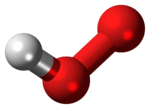Hydroperoxyl

| |
| Names | |
|---|---|
| Preferred IUPAC name
Hydroperoxyl | |
| Systematic IUPAC name
Dioxidanyl | |
| Other names
Peroxyl radical
| |
| Identifiers | |
3D model (JSmol)
|
|
| ChEBI | |
| ChemSpider | |
| 506 | |
PubChem CID
|
|
CompTox Dashboard (EPA)
|
|
| |
| |
| Properties | |
| HO2 | |
| Molar mass | 33.006 g·mol−1 |
| Acidity (pKa) | 4.88[1] |
| Basicity (pKb) | 9.12 (basicity of superoxide ion) |
Except where otherwise noted, data are given for materials in their standard state (at 25 °C [77 °F], 100 kPa).
| |
The hydroperoxyl radical, also known as the perhydroxyl radical, is the protonated form of superoxide with the chemical formula HO2.
Formation
Hydroperoxyl is formed through the transfer of a hydrogen atom or even ion(s) to molecular oxygen, an oxygen atom to a hydroxyl radical or a proton to a superoxide anion.[2]
Reactivity
The superoxide anion, O2−, and the hydroperoxyl radical are in equilibrium in aqueous solution:
- O2− + H2O ⇌ HO2 + OH−
The protonation/deprotonation equilibrium exhibits a pKa of 4.88;[1] consequently, about 0.3% of any superoxide present in the cytosol of a typical cell is in the protonated form.
Unlike O2−, which predominantly acts as a reductant, HO2 can act as an oxidant in a number of biologically important reactions, such as the abstraction of hydrogen atoms from tocopherol and polyunstaturated fatty acids in the lipid bilayer. As such, it may be an important initiator of lipid peroxidation.
Because dielectric constant has a strong effect on pKa, and the dielectric constant of air is quite low, superoxide produced (photochemically) in the atmosphere is almost exclusively present as HO2. As HO2 is quite reactive, it acts as a "cleanser" of the atmosphere by degrading certain organic pollutants. As such, the chemistry of HO2 is of considerable geochemical importance.
Effect on environment
Gaseous hydroperoxyl is involved in reaction cycles that destroy atmospheric ozone. It can be formed as a result of the oxidation of hydrocarbons in the troposphere.[2]
References
- ^ a b Reactivity of HO2/O2− Radicals in Aqueous Solution. J Phys Chem Ref Data, 1985. 14(4): p. 1041-1091
- ^ a b "Hydroperoxyl radical". Glossary of Meteorology. American Meteorological Society. 25 April 2012. Retrieved 22 August 2013.

